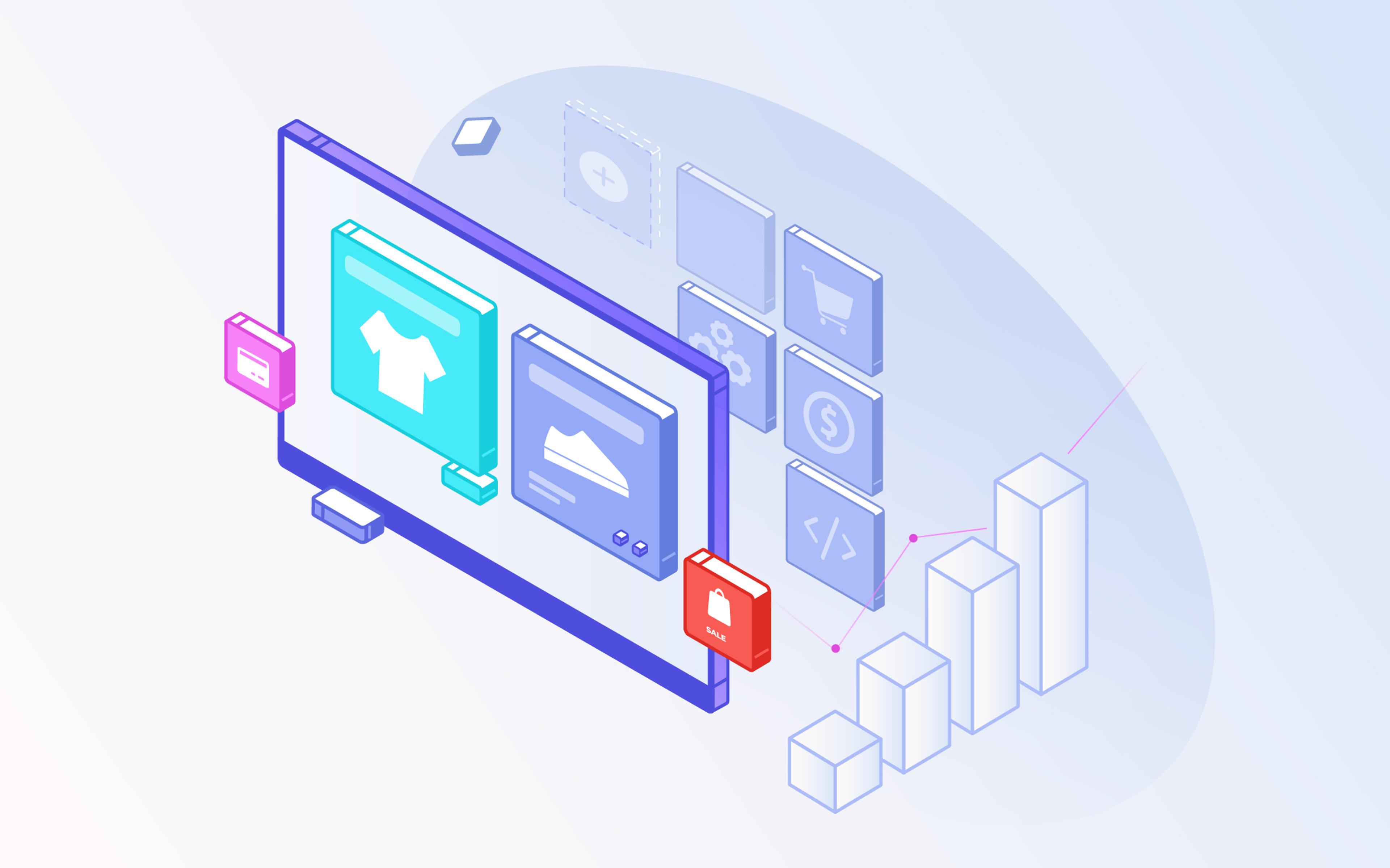As funding for headless commerce platforms reached a staggering $1.6 billion in 2021, these systems aren’t to be ignored. But how exactly do they compare to the so-called traditional “monolithic” eCommerce platforms, and when should you pick one over the other?
This guide will explore the headless commerce model, its benefits, how it differs from the all-in-one monolithic commerce system, and when it’s a good option for your brand.
What is headless commerce and how does it work?
Headless commerce is an eCommerce architecture where the frontend layer, or presentation layer, is decoupled from the backend commerce functionality.
Before we continue, let’s review the key differences between the frontend and backend:
-
Frontend: This is the user interface. Customers see and interact with the frontend, whether they’re accessing your eCommerce site, shopping app, digital kiosk or other shopping channels.
-
Backend: The backend is the behind-the-scenes, technical side of an eCommerce store the customer doesn’t see. The backend includes the technologies and tools that run in the background to ensure customers can shop and have smooth checkouts.
In headless commerce, the frontend and backend systems communicate via Application Programming Interfaces (APIs). This approach allows you to update the frontend, the customer-facing part of your site, independently of the backend and even use different development frameworks. This separation of concerns offers several benefits which we’ll explore below.
Examples of headless eCommerce solutions are Commerce Layer, Swell, and Nacelle.
4 benefits of headless commerce

Platforms that adopt a headless architecture offer several benefits compared to monolithic, or so-called traditional eCommerce platforms. Here are the top four advantages.
1. Omnichannel capabilities
In an omnichannel eCommerce experience, customers can start shopping on one channel or device and transition seamlessly to a different channel while the brand retains key information: common examples are a customer completing their purchase online, but selecting in-store pickup, or a customer buying something in-store and having the order show up their online order history.
Headless commerce makes it easy to serve the 74% of shoppers who use multiple channels to shop: because the same backend system can serve multiple storefronts, you can easily adapt customer touchpoints and shopping experiences to serve your eCommerce website, your mobile app, social media pages, and even physical locations. All will be completely integrated and feel seamless for your customers to interact with.
2. Technical flexibility
By decoupling backend and frontend, headless platforms allow your development team to pick the frontend stack, including third-party providers, that they’re most productive with. A headless architecture allows you to adopt your favorite content management system (CMS) to create rich editorial experiences, or elevate your storefront through progressive web apps (PWAs). This enables you to create engaging digital experiences that don’t face the limitations of traditional monolithic frontends.
When done right, headless architectures even allow you to refactor or completely replace entire parts of your backend with little to no impact on your frontend experience(s), which allows you to move and experiment much more quickly.
3. Superior personalization
Most monolithic eCommerce platforms severely limit your ability to personalize the customer experience by forcing you to work with proprietary templating language and preventing you from accessing customer data. With 80% of customers indicating they prefer brands that offer tailored experiences, eCommerce personalization is now table stakes for modern brands.
Headless platforms allow you to not only leverage basic eCommerce data, such as a customer’s profile and order history, but even augment it with brand-specific data points of your own. This allows you to create shopping experiences that feel built for your customer, boosting customer engagement, conversion rates and AOV.
4. Blazing fast performance
Storefronts that leverage a headless eCommerce platform can typically be deployed as static sites and put behind a global content delivery network (CDN) such as Cloudflare. In the hands of a capable development team, this can lead to incredible performance that would be hard to achieve with a monolithic platform.
A 2019 study by Portent has found that improving your loading speeds can boost your conversion rates anywhere from 1.5X to 2.5X! If your eCommerce site loads slowly, you are leaving lots of money on the table—literally.
3 drawbacks of going headless

In some cases, a headless build can lead to an unnecessarily complex architecture that causes more problems than it solves. Evaluating which eCommerce platform to use for your business needs is a complex process that should take into account both short-term and long-term factors as well as your budget and internal capabilities.
Here are three drawbacks of headless eCommerce platforms.
1. Technical capabilities
Launching a headless storefront requires you to create an in-house engineering team or hire an eCommerce agency for the long term. Headless sites require more ongoing maintenance to keep the lights on: Dependencies need to be updated, infrastructure needs to be maintained, and the site needs to be continuously monitored for bugs and performance issues.
In our experience, this additional effort has its upsides: It forces brand operators to get into a continuous optimization mindset, where they’re constantly identifying and capitalizing on new technology and other opportunities that can improve the shopping experience. Monolithic platforms, on the other hand, encourage a less intentional set-and-forget approach, which is definitely easier to execute, but also worse positioned for long-term scalability.
2. Time-to-market (and cost!)
Headless builds are typically associated with slightly higher timelines than monolithic builds. Adopting a headless architecture requires a significant investment in an agency or an in-house development team that will build your storefront, and this process can take anywhere between 2 and 4 months, depending on the complexity of the build.
Conversely, launching a store on a monolithic platform can be a much faster process with more competitive pricing, if you’re willing to settle for a more standardized look and purchase experience. This can be an acceptable compromise for smaller mom-and-pop businesses, but certainly not for a direct-to-consumer (DTC) brand with large long-term aspirations.
3. Integration effort
Headless eCommerce platforms are very flexible because you have full freedom to implement your storefront however you want. Unfortunately, this also means that many of the integrations and plugins that you can use out of the box with a monolithic platform will require a bit more work to be integrated in a headless architecture.
If you want to add reviews to your headless eCommerce website, for instance, you’ll need to work with your designers and engineers to figure out what the experience should look like, where to place the reviews, when to ask for them etc., and then implement and test the new functionality.
Ultimately, this extra effort is a good thing: A headless system asks you to be more disciplined and intentional in how you modify your storefront. This will force you to approach all initiatives with a critical eye rather than jumping from trend to trend, but it can be frustrating if you’re used to installing a plugin and forgetting about it.
The verdict: headless or monolithic?

The answer is: It depends on the use case. There’s no right or wrong answer.
While a headless commerce architecture has myriad benefits over monolithic architectures, it’s not ideal in all contexts. In certain scenarios, a headless commerce approach is the best way to build your vision and drive superior brand performance, while in others, you’re better off with a monolithic architecture that saves you time and money.
Headless commerce solutions might be right for:
-
Brands that want to offer a consistent customer experience across channels: Any brand that wants to deliver consistent customer experiences regardless of channels or devices should consider adopting this architecture.
-
Brands that feel their current platform is too rigid and restrictive: If you’ve ever felt your platform is limiting on the backend or frontend, it’s time to switch to a flexible headless setup.
-
Brands that put personalization front and center: If personalizing the shopping experience is critical for your brand’s strategy, then you should explore the capabilities that a headless build will unlock for your development team.
-
Online stores that have slow-loading pages: If sluggish pages have been a pain point for your eCommerce store, a headless architecture may be able to help by allowing you to leverage a more robust frontend ecosystem.
On the other hand, monolithic builds are a good solution for:
-
Brands with limited technical know-how: Headless commerce requires stronger technical capabilities which might not be everyone’s cup of tea. If you want to launch a commerce website without dealing with the underlying technicalities, headless is not for you.
-
Brands with time-to-market or financial constraints: If you’re on a tight timeline or a limited budget, a monolithic build will very often prove cheaper and quicker to launch than a headless counterpart.
-
Brands that want ready-made functionality: If you want to leverage ready-made features and integrations without thinking too deeply about how to integrate them in your shopping experience, a monolithic platform will give you more peace of mind.
Need help picking the right platform?

Headless architectures allow teams to move faster, address changing consumer needs, improve the user experience, and capitalize on omnichannel opportunities, but they’re not ideal for all brands.
Nebulab can help your new digital brand pick the right eCommerce platform for a greenfield build, or help your established brand design the right tech stack for its next growth spurt. We offer full-service consulting throughout all stages of your eCommerce project.
Reach out to see how we can help you create a vision for your eCommerce experience.



